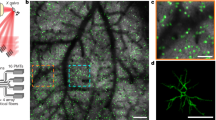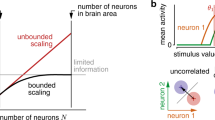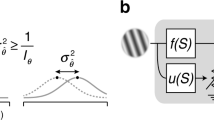Abstract
Computation in the nervous system often relies on the integration of signals from parallel circuits with different functional properties. Correlated noise in these inputs can, in principle, have diverse and dramatic effects on the reliability of the resulting computations1,2,3,4,5,6,7,8. Such theoretical predictions have rarely been tested experimentally because of a scarcity of preparations that permit measurement of both the covariation of a neuron’s input signals and the effect on a cell’s output of manipulating such covariation. Here we introduce a method to measure covariation of the excitatory and inhibitory inputs a cell receives. This method revealed strong correlated noise in the inputs to two types of retinal ganglion cell. Eliminating correlated noise without changing other input properties substantially decreased the accuracy with which a cell’s spike outputs encoded light inputs. Thus, covariation of excitatory and inhibitory inputs can be a critical determinant of the reliability of neural coding and computation.
This is a preview of subscription content, access via your institution
Access options
Subscribe to this journal
Receive 51 print issues and online access
$199.00 per year
only $3.90 per issue
Buy this article
- Purchase on Springer Link
- Instant access to full article PDF
Prices may be subject to local taxes which are calculated during checkout




Similar content being viewed by others
References
Shadlen, M. N. & Newsome, W. T. Noise, neural codes and cortical organization. Curr. Opin. Neurobiol. 4, 569–579 (1994)
Softky, W. R. & Koch, C. The highly irregular firing of cortical cells is inconsistent with temporal integration of random EPSPs. J. Neurosci. 13, 334–350 (1993)
Abbott, L. F. & Dayan, P. The effect of correlated variability on the accuracy of a population code. Neural Comput. 11, 91–101 (1999)
Romo, R., Hernandez, A., Zainos, A. & Salinas, E. Correlated neuronal discharges that increase coding efficiency during perceptual discrimination. Neuron 38, 649–657 (2003)
Salinas, E. & Sejnowski, T. J. Impact of correlated synaptic input on output firing rate and variability in simple neuronal models. J. Neurosci. 20, 6193–6209 (2000)
Dan, Y., Alonso, J. M., Usrey, W. M. & Reid, R. C. Coding of visual information by precisely correlated spikes in the lateral geniculate nucleus. Nature Neurosci. 1, 501–507 (1998)
Nirenberg, S., Carcieri, S. M., Jacobs, A. L. & Latham, P. E. Retinal ganglion cells act largely as independent encoders. Nature 411, 698–701 (2001)
Averbeck, B. B., Latham, P. E. & Pouget, A. Neural correlations, population coding and computation. Nature Rev. Neurosci. 7, 358–366 (2006)
Pouille, F. & Scanziani, M. Enforcement of temporal fidelity in pyramidal cells by somatic feed-forward inhibition. Science 293, 1159–1163 (2001)
Taylor, W. R. & Vaney, D. I. Diverse synaptic mechanisms generate direction selectivity in the rabbit retina. J. Neurosci. 22, 7712–7720 (2002)
Wilent, W. B. & Contreras, D. Dynamics of excitation and inhibition underlying stimulus selectivity in rat somatosensory cortex. Nature Neurosci. 8, 1364–1370 (2005)
Wehr, M. & Zador, A. M. Balanced inhibition underlies tuning and sharpens spike timing in auditory cortex. Nature 426, 442–446 (2003)
Leary, C. J., Edwards, C. J. & Rose, G. J. Midbrain auditory neurons integrate excitation and inhibition to generate duration selectivity: an in vivo whole-cell patch study in anurans. J. Neurosci. 28, 5481–5493 (2008)
Renart, A. et al. The asynchronous state in cortical circuits. Science 327, 587–590 (2010)
Trong, P. K. & Rieke, F. Origin of correlated activity between parasol retinal ganglion cells. Nature Neurosci. 11, 1343–1351 (2008)
de la Rocha, J., Doiron, B., Shea-Brown, E., Josic, K. & Reyes, A. Correlation between neural spike trains increases with firing rate. Nature 448, 802–806 (2007)
Dacey, D. M. & Petersen, M. R. Dendritic field size and morphology of midget and parasol ganglion cells of the human retina. Proc. Natl Acad. Sci. USA 89, 9666–9670 (1992)
Calkins, D. J. & Sterling, P. Absence of spectrally specific lateral inputs to midget ganglion cells in primate retina. Nature 381, 613–615 (1996)
Gabernet, L., Jadhav, S. P., Feldman, D. E., Carandini, M. & Scanziani, M. Somatosensory integration controlled by dynamic thalamocortical feed-forward inhibition. Neuron 48, 315–327 (2005)
Luna, V. M. & Schoppa, N. E. GABAergic circuits control input-spike coupling in the piriform cortex. J. Neurosci. 28, 8851–8859 (2008)
Mittmann, W., Koch, U. & Hausser, M. Feed-forward inhibition shapes the spike output of cerebellar Purkinje cells. J. Physiol. (Lond.) 563, 369–378 (2005)
Victor, J. D. & Purpura, K. P. Nature and precision of temporal coding in visual cortex: a metric-space analysis. J. Neurophysiol. 76, 1310–1326 (1996)
Murphy, G. J. & Rieke, F. Network variability limits stimulus-evoked spike timing precision in retinal ganglion cells. Neuron 52, 511–524 (2006)
Barlow, H. B., Hill, R. M. & Levivk, W. R. Retinal ganglion cells responding selectively to direction and speed of image motion in the rabbit. J. Physiol. (Lond.) 173, 377–407 (1964)
Weng, S., Sun, W. & He, S. Identification of ON-OFF direction-selective ganglion cells in the mouse retina. J. Physiol. (Lond.) 562, 915–923 (2005)
Cohen, M. R. & Newsome, W. T. Context-dependent changes in functional circuitry in visual area MT. Neuron 60, 162–173 (2008)
Gentet, L. J., Avermann, M., Matyas, F., Staiger, J. F. & Petersen, C. C. Membrane potential dynamics of GABAergic neurons in the barrel cortex of behaving mice. Neuron 65, 422–435 (2010)
Okun, M. & Lampl, I. Instantaneous correlation of excitation and inhibition during ongoing and sensory-evoked activities. Nature Neurosci. 11, 535–537 (2008)
Dunn, F. A., Lankheet, M. J. & Rieke, F. Light adaptation in cone vision involves switching between receptor and post-receptor sites. Nature 449, 603–606 (2007)
van Hateren, J. H. & Snippe, H. P. Information theoretical evaluation of parametric models of gain control in blowfly photoreceptor cells. Vision Res. 41, 1851–1865 (2001)
Sharp, A. A., O’Neil, M. B., Abbott, L. F. & Marder, E. Dynamic clamp: computer-generated conductances in real neurons. J. Neurophysiol. 69, 992–995 (1993)
Polyak, S. & Willmer, E. N. Retinal structure and colour vision. Doc. Ophthalmol. 3, 24–56 (1949)
Acknowledgements
We thank D. Dacey, O. Packer, J. Crook, B. Peterson and T. Haun for providing primate tissue; P. Newman and E. Martinson for technical assistance; T. Azevedo, E. J. Chichilnisky, F. Dunn, G. Murphy, S. Kuo, E. Shea-Brown, M. Shadlen and W. Spain for comments on the manuscript and discussions. Support was provided by HHMI and NIH (EY-11850).
Author information
Authors and Affiliations
Contributions
J.C. and F.R. designed and carried out the experiments, J.C. analysed the data and J.C. and F.R. wrote the paper.
Corresponding author
Ethics declarations
Competing interests
The authors declare no competing financial interests.
Supplementary information
Supplementary Information
The file contains Supplementary Text and Data, Supplementary Figures 1-6 with legends and additional references. (PDF 3116 kb)
Rights and permissions
About this article
Cite this article
Cafaro, J., Rieke, F. Noise correlations improve response fidelity and stimulus encoding. Nature 468, 964–967 (2010). https://doi.org/10.1038/nature09570
Received:
Accepted:
Published:
Issue Date:
DOI: https://doi.org/10.1038/nature09570
This article is cited by
-
Predictive encoding of motion begins in the primate retina
Nature Neuroscience (2021)
-
Perceptually unidentifiable stimuli influence cortical processing and behavioral performance
Nature Communications (2020)
-
Sensory coding accuracy and perceptual performance are improved during the desynchronized cortical state
Nature Communications (2017)
-
Enhanced Moran effect by spatial variation in environmental autocorrelation
Nature Communications (2015)
-
Impact of correlated inputs to neurons: modeling observations from in vivo intracellular recordings
Journal of Computational Neuroscience (2014)
Comments
By submitting a comment you agree to abide by our Terms and Community Guidelines. If you find something abusive or that does not comply with our terms or guidelines please flag it as inappropriate.



